Lifts Befitting a Landmark
May 1, 2018

The Sydney Harbour Bridge is a steel through arch bridge across Sydney Harbour that carries rail, vehicular, bicycle and pedestrian traffic between Sydney’s Central Business District (CBD) and the North Shore.[1]
This bridge is among Australia’s best-known and most-photographed landmarks. It is the world’s largest (but not longest) steel arch bridge, with the top of the bridge standing 134 m above the harbor. Including its approach spans, the bridge is 1,149 m long, with the main span covering 503 m. It provides 49 m of clearance for vessels below.[2] It facilitates eight lanes of vehicle traffic, two rail tracks and dedicated pedestrian and bicycle lanes.[1] Construction started in 1924, and the span was opened to traffic on March 19, 1932.[2]
In 1989, businessman Paul Cave put together a group climb on the bridge’s arches as part of leadership group YPO’s (then known as the Young Presidents Organization) World Congress.[3] This inspired the idea of opening the arches for guided tours, and, in 1998, BridgeClimb was born, allowing ordinary people to make the trek of a lifetime to the top of one of Australia’s most-recognizable manmade structures and enjoy stunning views of the equally iconic Sydney Opera House, as well as the city’s CBD and surrounding areas.
There are different types of climbs, but the full-experience BridgeClimb starts near the southeast pylon of the bridge, up the arch to the top, then across the bridge and back down the other arch. This trip originally included climbing ladders to the steel arch, but to facilitate easier and safer access, it was decided to install panoramic elevators.
As the Sydney Harbour Bridge is considered a national landmark, it was important to make the elevators as unobtrusive as possible. Traction elevators would have required the installation of enclosed hoistways. The decision was made to instead use a rack-and-pinion design, which would minimize the structural protrusions. GEDA GmbH of Germany, a longtime manufacturer of industrial, construction and material elevators, was chosen to supply the rack-and-pinion equipment. GEDA worked with Sydney Hoist (installer), Lendlease (project/construction manager) and the City of Sydney to design and engineer an elevator that would meet the project requirements, while fitting into the historical design of the bridge.
GEDA provided two special SH-1500 elevators, each with a capacity of 1500 kg. The elevators were provided with automatic doors in glass, along with glass cladding — quite unusual for rack and pinion elevators.
The elevators’ structural components, guide rails and landing frames were all painted with a corrosion-resistant coating to match the existing steel structure of the bridge.
One particular challenge was that the glass base enclosures had to be installed on expansion joints that can move 150 mm in either direction, depending upon the temperature. The team overcame this problem by mounting most of the equipment on the center-span side of the joint (fixed to the kingpost), then locating sensitive parts, such as the base entrance door, on the other side.
This layout presented some challenges, however. There was no foundation available on the center-span side to install base plates, mast sections and buffers. Engineers designed cantilevered platforms, welded to the kingposts, that serve as foundations for the lifts. Because of the structure of the kingposts — steel plates mated together with thousands of rivets — close examination was necessary to determine where to locate each platform. The location had to be unobstructed by rivets, but capable of supporting the platforms (which are subject to impacts of 18 mT coming from the mast and buffers). The base fence enclosures (heavyweight design with glass panels and stainless-steel frames) and integrated landing doors rest on floating racks coated with Teflon™. The rack is attached to the landward side of the joint, while the base fence enclosure is mounted to the kingpost, on the center-span side.
Because the bridge had to remain open to vehicles throughout the installation process, it was only possible to work for a few hours at night, when bridge use was lighter.
With the installation of the GEDA rack-and-pinion elevator, the ascent to the Sydney Harbour Bridge arch is, indeed, a safer proposition, but BridgeClimb continues to offer every bit of the fun and excitement that has been thrilling tourists for 20 years.
References
[1] Wikipedia. “Sydney Harbour Bridge” (en.wikipedia.org/wiki/Sydney_Harbour_Bridge)
[2] Sydney Harbour Bridge Info. (www.sydneyharbourbridge.info)
[3] BridgeClimb Sydney. (www.bridgeclimb.com)
Get more of Elevator World. Sign up for our free e-newsletter.








